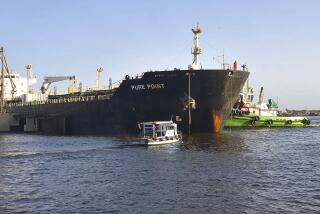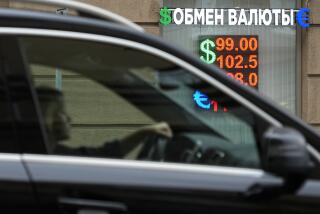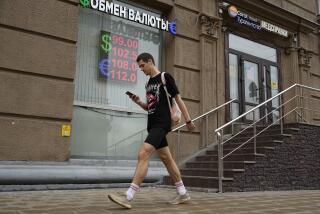With West’s Support, Russia Acts to Stabilize Currency : Economy: The slumping ruble will be made convertible into other currencies at a fixed rate.
- Share via
MOSCOW — Strengthened by new promises of $24 billion in Western assistance, the Russian government announced Tuesday that it will make the ruble convertible into other currencies as a major step toward establishing a free-market economy here.
Konstantin Kagalovsky, a senior Russian official, said the government expects that the country’s much-weakened currency will trade initially this summer at roughly 80 rubles to the U.S. dollar--a 33% surge in value--and that the Russian Central Bank will then use Western aid to maintain the exchange rate.
“From Aug. 1, we intend to have a fixed rate of exchange, making the ruble convertible . . . within a margin of 7.5% up or down,” Kagalovsky said, outlining plans that will allow Russians, as well as international investors, to decide whether to hold their money in rubles--or dollars.
Although the government will test the market for a month by allowing the ruble to float freely, 80 rubles per dollar would be “realistic,” Kagalovsky said, and the Russian Central Bank is prepared to support such a rate with its reserves and the new foreign credits.
Kagalovsky, who is in charge of Russia’s relations with the International Monetary Fund and World Bank, described the long-discussed but difficult move as one of the most important reforms the government must undertake in transforming the old Soviet economy, based on state ownership and central planning, into one driven by the market forces of supply and demand.
Additional reforms--a sharp increase in interest rates, further budget cuts and an end to most controls on exports and imports--will be undertaken at the same time, Kagalovsky said, as part of the second phase of the government’s efforts to establish a market economy here.
That program won broad approval at last week’s meetings of the IMF, World Bank and Group of Seven major industrialized nations in Washington, Kagalovsky said, and on the basis of it Russia will receive $24 billion in Western loans and credits this year, including $6 billion for a currency stabilization fund to help make the ruble convertible.
While the move to a convertible currency will probably attract crucial foreign investment by assuring Western business people that they will be able to turn their ruble profits into dollars, deutschemarks and yen, the main effect should be restoration of domestic confidence in the ruble, whose value has dropped so low that even Russian firms prefer barter deals to cash payments.
“The collapse of the ruble as a working currency has accelerated the collapse of the Russian economy as a whole,” a European banker commented. “We hope the converse is true--that strengthening the ruble will strengthen the whole economy.”
When a currency is “convertible,” it is readily bought or sold for other currencies, used in foreign trade and accepted by international financial institutions; it should be backed by sufficiently large reserves of gold, major currencies and credits from the IMF and be supported by well-functioning business and banking systems as well as sound governmental fiscal and monetary policies.
“Certainly, there is no hope for economic recovery while the ruble remains virtually worthless,” said an American economist advising the Russian government. “More than convertibility is required, but that’s where they must start.”
In making the ruble convertible, the government in fact hopes to force Russian industry into greater productivity and efficiency through foreign competition, for those who are not satisfied with the quality or price of Russian goods will be able to import better or cheaper products from abroad.
But Andrei P. Vavilov, the first deputy finance minister, acknowledged that ruble convertibility, along with other reforms planned for this summer, will also bring further increases in prices beyond the 12- to 14-fold rise already experienced this year.
“Our current price system is not proportional to the world price system,” Vavilov explained, “and prices will continue to grow until the end of the year. But they will not be rising steadily. We shall have what is known as ‘corrective’ inflation--when the prices of some goods keep growing, while for others they become fixed and even begin to reduce.”
Vavilov predicted that inflation, still running at 25% a month, will be cut to 5% a month by the end of the year if the government succeeds in reducing its budget deficit to less than 5% of the gross national product by the fourth quarter from the present 7% to 8%.
Still, there are plans to increase the money supply by as much as 30% before the end of June, Vavilov noted, by permitting $2 billion in additional bank credits to prevent the potential bankruptcy of thousands of Russian enterprises.
Later, however, the basic interest rate charged by the Russian Central Bank will be raised from 50% to about 80% a year, bringing it closer to the rate of inflation, attracting investment funds and reducing the budget deficit.
A convertible currency was a condition of Russia’s membership in the IMF, and Moscow even abandoned plans for a special exchange rate for foreign investments in favor of one rate for all transactions.
Late last year, the government eliminated all but three of the dozens of different exchange rates that it formerly used depending on who was buying or selling the ruble and for what purpose, but severe restrictions remained on the amount of rubles that could be converted into foreign currencies and what they could be purchased for.
The ruble now sells at about 120 to the dollar on the open market, and it has gone for even 200 rubles to the dollar in recent months. The government also has a “special commercial rate” of 55 rubles to $1 for Russian enterprises engaged in export, and a third rate is used for inter-bank transfers.
The precipitous decline of the ruble is a good measure of the collapse of the old Soviet economy. Only six months ago, the ruble was officially valued at $1.80, but on the black market it was already down to 4 cents. With the disintegration of the Soviet Union and the deepening economic slump at the end of 1991, it declined further to the point where a ruble is worth less than one American penny.
So low is confidence in the ruble--farmers often refuse to accept cash for their produce, and factories resort to complex barter deals--that the government had considered abandoning it for a totally new currency as other former Soviet republics are doing. In the end, leaders decided that this would be too complex a move.
“The Soviet ruble is something we have inherited,” Kagalovsky said. “This may not be the best possible legacy, but we have inherited it.”
Vavilov said that the other former Soviet republics, most of which have announced creation of their own currencies, will have to decide whether to continue using rubles in their domestic economies or foreign trade or withdraw entirely from the ruble zone.
More to Read
Sign up for Essential California
The most important California stories and recommendations in your inbox every morning.
You may occasionally receive promotional content from the Los Angeles Times.













